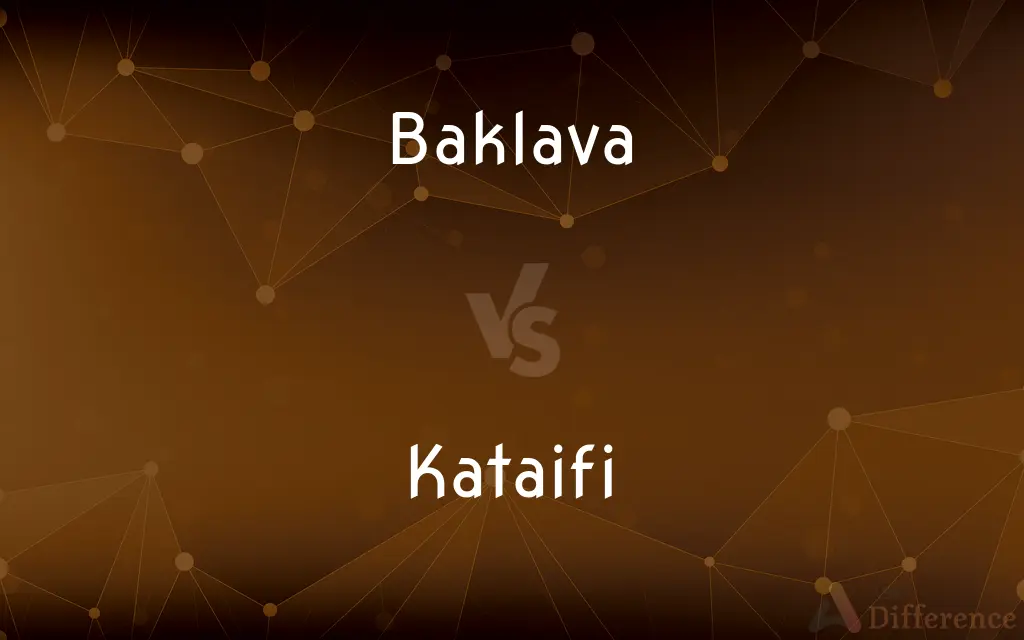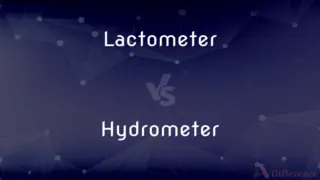Baklava vs. Kataifi — What's the Difference?
Edited by Tayyaba Rehman — By Urooj Arif — Updated on March 28, 2024
Baklava is a layered pastry dessert made of filo dough, nuts, and syrup, known for its sweet, rich flavor, whereas kataifi is a pastry made with a shredded wheat dough, filled with nuts, and soaked in syrup, offering a unique texture.

Difference Between Baklava and Kataifi
Table of Contents
ADVERTISEMENT
Key Differences
Baklava is a rich, sweet pastry made of layers of filo dough filled with chopped nuts and sweetened with syrup or honey. It is a traditional dessert in many Middle Eastern and Mediterranean countries, celebrated for its delicate layers and crisp texture. Whereas, kataifi uses a unique form of shredded wheat dough instead of the smooth sheets of filo used in baklava. This creates a distinctive texture that is both crunchy and tender, providing a different mouthfeel.
The filling for baklava typically includes a variety of nuts such as walnuts, pistachios, and almonds, often spiced with cinnamon or cloves to enhance the flavor. On the other hand, kataifi, while also using nuts for the filling, might incorporate additional ingredients like cream or cheese in some variations, offering a broader range of flavors and textures.
Baklava is usually cut into small pieces, either in triangles, squares, or diamond shapes, before baking. The syrup or honey is poured over the cooked pastry, allowing it to soak into the layers. Kataifi, however, is often rolled or layered into different shapes, such as coils or nests, before the syrup is added, making the presentation and texture markedly different.
The syrup used in baklava often contains lemon juice or rose water, adding a subtle flavor complexity to the sweetness. Kataifi’s syrup might similarly be flavored but can also include ingredients like orange blossom water, providing a different but equally aromatic sweetness.
Despite their differences, both baklava and kataifi are served as desserts and are especially popular during festive occasions and celebrations. They share a richness and sweetness that make them favorites for many, though their textures and specific flavors set them apart.
ADVERTISEMENT
Comparison Chart
Dough Type
Filo dough, layered
Shredded wheat dough
Texture
Crisp, layered
Crunchy, tender
Filling
Nuts (walnuts, pistachios, almonds)
Nuts, sometimes with cream or cheese
Shape
Cut into pieces (triangles, squares)
Rolled or layered into shapes (coils, nests)
Syrup Flavor
Lemon juice, rose water
Orange blossom water, lemon juice
Compare with Definitions
Baklava
Traditionally cut into diamonds or squares before baking.
She carefully cut the baklava into diamond shapes, ensuring each piece was perfectly sized.
Kataifi
Often formed into coils or nests, adding to its presentation.
The kataifi was shaped into small nests, each filled with a creamy center, before being soaked in syrup.
Baklava
The layered filo dough provides a crisp, flaky texture.
The crisp texture of the baklava made it a delightful contrast to the creamy ice cream served with it.
Kataifi
Uses a distinctive shredded dough for a crunchy texture.
The kataifi's shredded wheat dough added an interesting texture to the dessert, making it a hit.
Baklava
A sweet dessert made of layered filo pastry, filled with nuts and soaked in syrup.
For dessert, she prepared baklava, layering buttered filo dough with finely chopped pistachios.
Kataifi
Can include additional fillings, offering a creamy texture.
The center of the kataifi hid a surprise filling of sweetened cream, adding a delightful creaminess.
Baklava
Commonly uses a mix of walnuts, pistachios, and almonds.
The baklava featured a generous mixture of walnuts and almonds, spiced with a hint of cinnamon.
Kataifi
The syrup may include orange blossom water for a fragrant sweetness.
The syrup, infused with orange blossom water, gave the kataifi a floral aroma that complemented its sweetness.
Baklava
Known for its sweet syrup and rich nut filling.
The baklava was incredibly rich, its sweetness perfectly balanced by the crisp filo layers.
Kataifi
A dessert made with shredded wheat dough, nuts, and syrup, known for its unique texture.
He rolled the kataifi dough around a filling of chopped nuts, preparing it for baking.
Baklava
Baklava (, or ; Ottoman Turkish: باقلوا) is a layered pastry dessert made of filo pastry, filled with chopped nuts, and sweetened with syrup or honey. It was one of the most popular sweet pastries of Ottoman cuisine.The pre-Ottoman origin of the dish is unknown, but, in modern times, it is a common dessert of Iranian, Turkish and Arab cuisines, and other countries of the Levant and Maghreb, along with the South Caucasus, Balkans, and Central Asia.
Kataifi
A very fine vermicelli-like pastry used to make desserts in various Mediterranean and Middle Eastern cuisines, particularly Palestinian.
Baklava
A dessert made of paper-thin layers of pastry, chopped nuts, and honey.
Baklava
A popular sweet pastry found in many cuisines of the Middle East and the Balkans, made of chopped nuts layered with phyllo pastry. since c. 1650; modern spelling since 1800s
Baklava
Rich Middle Eastern cake made of thin layers of flaky pastry filled with nuts and honey
Common Curiosities
What is kataifi?
Kataifi is a pastry made with shredded wheat dough, typically filled with nuts, and soaked in syrup.
What is baklava?
Baklava is a layered pastry dessert made from filo dough, filled with nuts, and soaked in syrup.
Can kataifi include fillings other than nuts?
Yes, kataifi can also include cream or cheese fillings for added flavor and texture.
What shapes do baklava and kataifi come in?
Baklava is usually cut into pieces like diamonds or squares, while kataifi is formed into shapes like coils or nests.
Are baklava and kataifi served at specific times?
Both are popular during festive occasions and celebrations but can be enjoyed anytime as a rich, sweet dessert.
Can the nuts in baklava and kataifi be substituted?
Yes, the nuts in both desserts can be substituted or mixed according to personal preference or dietary needs.
How do baklava and kataifi differ in texture?
Baklava has a crisp, layered texture from filo dough, while kataifi offers a crunchy yet tender bite from its shredded wheat dough.
Which dessert is richer in flavor?
Both are rich in flavor, but baklava’s use of layered filo adds a buttery richness, whereas kataifi’s texture offers a different type of richness through its filling.
What kind of syrup is used for these desserts?
Both desserts use a sweet syrup, often flavored with lemon juice, rose water, or orange blossom water.
Is kataifi more complicated to make than baklava?
Kataifi can be considered more challenging due to handling the shredded dough, but both require skill to assemble.
How long do baklava and kataifi last?
Both can last for several days when stored properly in an airtight container at room temperature.
Are baklava and kataifi gluten-free?
Traditionally, no, due to the wheat-based dough, but gluten-free versions can be made with appropriate substitutes.
Can baklava and kataifi be frozen?
Yes, both desserts freeze well and can be enjoyed at a later date by thawing at room temperature.
Share Your Discovery

Previous Comparison
Lactometer vs. Hydrometer
Next Comparison
Forehead vs. TempleAuthor Spotlight
Written by
Urooj ArifUrooj is a skilled content writer at Ask Difference, known for her exceptional ability to simplify complex topics into engaging and informative content. With a passion for research and a flair for clear, concise writing, she consistently delivers articles that resonate with our diverse audience.
Edited by
Tayyaba RehmanTayyaba Rehman is a distinguished writer, currently serving as a primary contributor to askdifference.com. As a researcher in semantics and etymology, Tayyaba's passion for the complexity of languages and their distinctions has found a perfect home on the platform. Tayyaba delves into the intricacies of language, distinguishing between commonly confused words and phrases, thereby providing clarity for readers worldwide.
















































